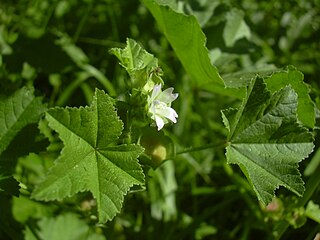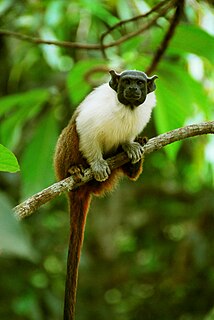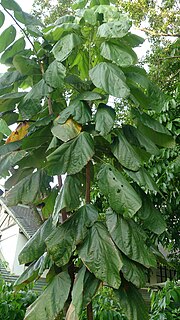Related Research Articles

Sorghum is a genus of about 25 species of flowering plants in the grass family (Poaceae). Some of these species are grown as cereals for human consumption and some in pastures for animals. One species, Sorghum bicolor, was originally domesticated in Africa and has since spread throughout the globe. Seventeen of the 25 species are native to Australia, with the range of some extending to Africa, Asia, Mesoamerica, and certain islands in the Indian and Pacific Oceans. One species is grown for grain, while many others are used as fodder plants, either cultivated in warm climates worldwide or naturalized in pasture lands. Sorghum is in the subfamily Panicoideae and the tribe Andropogoneae.

A bicolor cat or piebald cat is a cat with white fur combined with fur of some other color, for example black or tabby. There are various patterns of bicolor cat. These range from Turkish Van pattern through to solid color with a throat locket.

Quercus bicolor, the swamp white oak, is a North American species of medium-sized trees in the beech family. It is a common element of America's north central and northeastern mixed forests. It can survive in a variety of habitats. It forms hybrids with bur oak where they occur together in the wild.

Malvaceae, or the mallows, is a family of flowering plants estimated to contain 244 genera with 4225 known species. Well-known members of economic importance include okra, cotton, cacao and durian. There are also some genera containing familiar ornamentals, such as Alcea (hollyhock), Malva (mallow) and Lavatera, as well as Tilia. The largest genera in terms of number of species include Hibiscus, Sterculia, Dombeya, Pavonia and Sida.

The tufted titmouse is a small songbird from North America, a species in the tit and chickadee family (Paridae). The black-crested titmouse, found from central and southern Texas southward, was included as a subspecies, but now is considered a separate species, (Baeolophus atricristatus).

The pied tamarin is a Critically Endangered primate species found in a restricted area of the Brazilian Amazon Rainforest. It was named the mascot of Manaus, Brazil in 2005.

Lespedeza is a genus of some 40 species of flowering plants in the pea family (Fabaceae), commonly known as bush clovers or Japanese clovers (hagi). The genus is native to warm temperate to subtropical regions of eastern North America, eastern and southern Asia and Australasia.

Loxocemus bicolor, sole member of the monotypic family Loxocemidae, is a species of python-like snake found in Mexico and Central America. No subspecies are currently recognized. Analyses of DNA show that Loxocemus is most closely related to the true pythons and the sunbeam snakes.

The red-tailed black shark, also known as the redtail shark and redtail sharkminnow, is a species of freshwater fish in the carp family, Cyprinidae. It is endemic to Thailand and currently critically endangered, but common in aquaria, where it is prized for its deep black body and vivid red or orange tail. The red-tailed black sharks seen in the aquarium trade today are all captive bred.

The swamp wallaby is a small macropod marsupial of eastern Australia. This wallaby is also commonly known as the black wallaby, with other names including black-tailed wallaby, fern wallaby, black pademelon, stinker, and black stinker on account of its characteristic swampy odour.

Sorghum bicolor, commonly called sorghum and also known as great millet, durra, jowari / jowar, or milo, is a grass species cultivated for its grain, which is used for food for humans, animal feed, and ethanol production. Sorghum originated in Africa, and is now cultivated widely in tropical and subtropical regions.
Oecomys bicolor, also known as the white-bellied oecomys or bicolored arboreal rice rat, is a species of rodent in the genus Oecomys of family Cricetidae. It has a wide distribution in the Amazon biome, occurring in northwestern Brazil, northern Bolivia, eastern Peru, eastern Ecuador, eastern Colombia, much of Venezuela, Guyana, Suriname, and French Guiana, and extends into eastern Panama, but it may contain more than one species.

The dark-backed weaver, also known as the forest weaver, is a species of bird in the family Ploceidae. It is found in Angola, Burundi, Cameroon, Republic of the Congo, Democratic Republic of the Congo, Equatorial Guinea, Eswatini, Gabon, Kenya, Malawi, Mozambique, Nigeria, Rwanda, Somalia, South Africa, South Sudan, Tanzania, Uganda, Zambia, and Zimbabwe.

The black giant squirrel or Malayan giant squirrel is a large tree squirrel in the genus Ratufa native to the Indomalayan zootope. It is found in forests from northern Bangladesh, northeast India, eastern Nepal, Bhutan, southern China, Myanmar, Laos, Thailand, Malaysia, Cambodia, Vietnam, and western Indonesia.

The bicolored roundleaf bat is a species of bat in the family Hipposideridae found in Indonesia, Malaysia, the Philippines, Thailand, and Timor-Leste. This bat inhabits caves, rock crevices and tunnels among lowland forests. They roost in large numbers and consumer mostly small winged insects. Their navigation and hunting skills come from the use of echolocation. Its leafnose is used to release ultrasonic shouts to distinguish its surroundings. Echolocation is also used to distinguish other species based on their wingbeat and size. The habitat of this bat decides the color of its fur. Bleaching fumes of a cave environment will cause an orange colored fur. Those who inhabit a well-ventilated roost will be a light brown color.

Xylococcus is a monotypic genus of flowering plants in the heath family which contains the single species Xylococcus bicolor, the mission manzanita.

Theobroma bicolor, known commonly as the mocambo tree, jaguar tree, balamte, or pataxte, among various other common names, is a tree in the genus Theobroma, which also contains the better-known Theobroma cacao. It is found in Central and South America, including stretches of the Amazon rainforest in Brazil, Colombia, Ecuador, and Peru.
Parkia bicolor, the African locust-bean, is a species of flowering plant, a tree in the pea family, Fabaceae. It is native to tropical West and Central Africa. Its natural habitats are tropical moist lowland forests, swampland, woodland and savannah.

A Kambo cleansing, also known as a Kambo circle or Kambo ceremony, Kambo, vacina-do-sapo, or sapo, is a purge using skin secretions of the kambô, a species of frog. The effects on humans usually include nausea, vomiting, and diarrhea; use of kambo has caused several deaths. Kambo, which originated as a folk medicine practice among the Amazon indigenous peoples, is also administered as an alternative medicine treatment in the West, often as a pseudoscientific cleanse or detox. The ceremony involves burning an arm or leg and applying the kambo secretion directly to the burn. Promoters claim that kambo helps with several illnesses or injuries. There is no scientific evidence that it is an effective treatment.
The black-and-white langur is a species of monkey in the family Cercopithecidae. It was formerly considered a subspecies of the Black-crested Sumatran langur, Presbytis melalophos but genetic analysis revealed that these are separate species.
References
- ↑ Biolib.cz - Scapeuseboides bicolor. Retrieved on 8 September 2014.